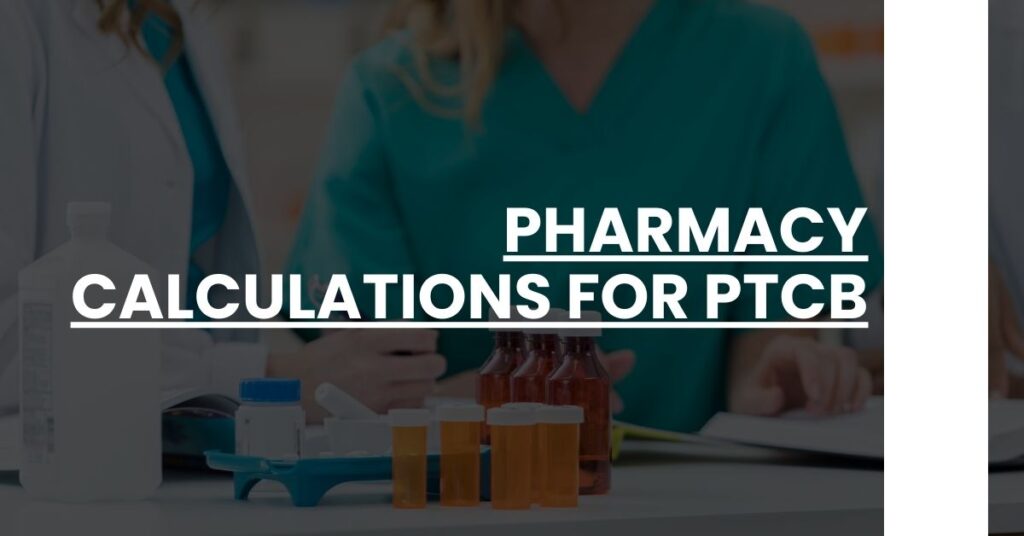Pharmacy calculations for PTCB are your gateway to ace the certification exam.
- Essential Math Skills: Sharpen your arithmetic to excel in pharmacy calculations.
- Varied Calculation Types: Master diverse pharmaceutical math from dosages to drip rates for PTCB readiness.
- Real-World Application: Apply calculation skills directly to ensure patient safety and care in your pharmacy career.
Elevate your career with proficiency in pharmacy calculations for PTCB.
Understanding the PTCB Exam
Pharmacy technicians play a critical role in healthcare, serving as the linchpin between patients, pharmacists, and prescriptions. At the heart of their expertise lies the Pharmacy Technician Certification Exam (PTCB), a rigorous test that assesses their preparedness to deliver diligent care. For those entering this field, understanding the PTCB’s landscape is the first step in establishing a fruitful career.
The PTCB Structure:The PTCB exam is comprehensive, covering numerous domains of pharmacy practice. Out of these, pharmacy calculations emerge as a pivotal aspect, making up more than a fifth of the exam content. For the aspiring pharmacy technician, prowess in this area is not just beneficial—it’s essential.
Why Pharmacy Calculations Matter:Imagine a scenario where dosage errors occur—consequences can range from ineffectiveness to severe harm. Pharmacy calculations for PTCB are, therefore, more than just numbers; they are the safeguarding thread in the fabric of patient health.
The Calculations Component:Within the exam, you’ll encounter a spectrum of scenarios that test your numerical acumen. Whether it’s determining the correct medication dose or calculating an IV flow rate, the PTCB requires you to be adept, accurate, and agile with numbers.
As you prepare, bear in mind the gravity of accuracy and the impact your calculations will have in a real-world setting. With each practice problem and study session, you’re not just inching closer to certification; you’re honing a life-saving skillset.
Basic Math Skills Required
The journey to mastering pharmacy calculations begins with a solid foundation in basic math. Here are the skills you must polish:
Arithmetic:
- Addition, subtraction, multiplication, division—these operations form the cornerstone of more complex calculations.
- Working with fractions and decimals, since medication dosages often involve precise measurements.
- Percentage calculations, which are frequently used when determining concentrations and dilutions.
Ratios and Proportions:Understanding ratios and proportions is vital, especially when scaling recipes up or down and when working with different units of measure.
Metric System Mastery:The metric system is the standard in pharmacy, so be comfortable with liters, grams, and meters, and their conversions.
This math may seem elementary, but don’t be misled—the implications of these numbers carry significant weight. Approach them with the due diligence and practice incessantly; these are the tools that will carry you through the PTCB and into your career.
Types of Calculations on the PTCB
Pharmacy technicians encounter a vast range of calculations, each with its nuances and requirements. Below, let’s delve into the different calculation types that are crucial to perform with precision.
Dosage Calculations
The Core of Pharmacology:
- Understanding the Prescription: Deciphering what the prescriber intends for the patient.
- Calculating Dosages for Varying Patient Groups: Adjusting calculations based on patient age, weight, or specific medical conditions.
This crucial segment of pharmacy calculations gauges your ability to interpret and execute prescriptions safely and effectively.
Conversion Calculations
Unit Interplay:
- Juggling between systems, such as the metric, apothecary, and avoirdupois systems, pharmacy technicians must convert units seamlessly.
- Temperature Transitions: Converting between Celsius and Fahrenheit, which is often overlooked but equally essential.
The variety of unit conversions on the PTCB can be formidable. However, with sustained practice, they become second nature, paving the way to confident test-taking and professional practice.
IV Flow Rates and Compounding Calculations
- The Intricacies of IV Therapy: Calculating flow rates to ensure patients receive medication at the correct pace.
- The Art of Compounding: Determining the precise measurements for combining ingredients to create a medication tailored to patient needs.
These calculations require meticulous attention to detail and an ever-present awareness of the clinical implications.
Measurement Conversions
Understanding and performing measurement conversions are among the fundamental skills expected of a pharmacy technician, both for the PTCB exam and in daily practice. As medication dosages are often provided in one unit, but administered in another, the ability to convert swiftly and accurately is indispensable.
Here are the measurement conversions you’ll need to master:
- Metric to Imperial (and vice versa): Translating grams to ounces, liters to pints, or meters to feet can be crucial, especially when patient instructions are in a different system.
- Apothecary Measurements: Although less common, familiarity with drams, minims, and grains might occasionally be necessary.
- Unit Equivalents: Knowing that 1 mL is equivalent to 1 cc (cubic centimeter) can prevent confusion and ensure accuracy.
The ability to navigate between these conversions without hesitation is a marker of a proficient pharmacy technician. While these may just be a fraction of the overall PTCB material, they are often the computations that underpin a correctly filled prescription. Dive deep into practice problems, make flashcards, and challenge yourself to become fluent in this language of conversion.
Remember, this journey through pharmacy calculations is not a sprint, but a marathon. Each step, each number crunched, is shaping you into a dependable guardian of patient safety. Embrace the complexity, as with it comes the capacity to change lives—one calculation at a time.
IV Flow Rates and Drip Factors
When it comes to intravenous (IV) therapies, calculating flow rates and drip factors are vital to ensuring patients receive their medications at the correct pace. This is more than a mathematical exercise—it’s an aspect of patient care that demands precision and understanding.
IV therapy is used to deliver fluids, medications, or nutrients directly into the bloodstream, hence, the calculations related to IVs are crucial. For the PTCB, being skilled in these pharmacy calculations can make a significant difference.
Here’s what you need to know:
- Flow Rate: It’s the speed at which IV fluid is administered, typically measured in mL per hour (mL/hr).
- Drop Factor: Also known as the drip factor, it’s the number of drops per mL, depending on the IV set used, and it’s typically printed on the IV tubing package.
To calculate the IV flow rate, you need the volume of fluid to be infused (in mL) and the time frame (in hours) the doctor has ordered it over. The formula looks like this:
For drip rates, you’ll need to factor in the drip factor:
Practicing these calculations will bolster your ability to ensure precise administration in real-world settings and put you in good stead for the PTCB exam. For additional resources on this topic, visit Mometrix to deepen your understanding and proficiency.
Compounding and Alligations
The art of compounding harks back to the very origins of pharmacy—it’s both a science and a craft. A compounded medication is custom-made to fit the unique needs of a patient, something not commercially available.
Within compounding, the ability to calculate concentrations, quantities, and dilutions is requisite, requiring a blend of precision and care. Alligation is another essential technique, especially when you need to mix solutions of different concentrations to achieve a desired strength. It’s a method steeped in tradition yet fundamental in modern practice.
An alligation involves the following process:
- Alligation Medial: Calculating the needed quantity of two solutions to achieve a desired concentration.
- Alligation Alternate: Determining the ratio in which to mix two components of different strengths to result in the desired concentration.
These processes ensure that customized medications meet the exact specifications ordered by a prescriber, a responsibility not taken lightly by pharmacy technicians.
Compounding calculations are more than numbers on paper; they’re a testament to a technician’s dexterity and diligence. To prepare, give time to practice these nuanced calculations and review materials like the PTCB exam content outline to understand the expectations thoroughly.
Strategies for Accuracy
If there’s one thing that pharmacy technicians can’t afford, it’s an error in their calculations. The responsibility that comes with pharmacy calculations for PTCB carries with it the well-being of patients. Here are some strategies to ensure accuracy:
- Double-check your work: Always take the time to review your calculations, and when possible, have a system that allows for a second set of eyes.
- Stay organized: Keep your workspace and calculations tidy. Clutter can lead to mistakes.
- Use a calculator: While fundamental math skills are essential, a calculator is a practical tool that reduces the chance of human error.
- Regular practice: Practice not only helps retain information but also increases the speed and accuracy of your calculations.
Remember, your goal is not just to pass the PTCB but to excel in a way that merits the trust placed in you by patients and pharmacists alike. For an insightful read on the importance of these strategies, explore resources like those from the American Society of Health-System Pharmacists.
Practice and Resources
The mantra ‘practice makes perfect’ is particularly pertinent regarding pharmacy calculations for PTCB. The more time you spend solving calculation problems, the more natural they will feel during the exam—and in the workplace.
To channel your practice effectively, consider these avenues:
- Apps and Online Quizzes: Digital tools can offer interactive ways to test your skills and track your progress.
- PTCB Practice Exams: Simulating exam conditions can help reduce anxiety on the actual test day.
- Pharmacy Calculation Books: Texts like the “APhA Complete Review for Pharmacy Math” provide a wealth of practice problems, serving as an excellent resource. Dive into this comprehensive book to stretch your mathematical prowess.
Engaging with a mix of resources enriches your study routine, making preparation a dynamic and less arduous task.
Legal and Safety Considerations
Pharmacy calculations for PTCB are not just an academic hoop to jump through; they’re closely tied to compliance and patient safety. Incorrect calculations can lead to serious legal repercussions and, more importantly, adverse effects on patient health.
Consider these points:
- Legality: Being certified means that you’re legally recognized as having met specific competencies, including calculation proficiency.
- Patient Safety: Every correct calculation contributes to the safe dispensing and administration of medication.
As a technician, you’re entrusted with a tremendous responsibility. The numbers you work with translate to the health outcomes of real people. For insights into the significant impact of these responsibilities, consider delving into studies such as those found on NCBI.
Conclusion: Preparing for Success on the PTCB
As you approach the end of this comprehensive dive into pharmacy calculations for PTCB, remember that these skills are your trusty companions—the bridge between theoretical knowledge and tangible impact. With diligence, practice, and the mindset of a learner, you can master these calculations and gain a rewarding certification that speaks to your dedication.
The key to excellence in the PTCB and beyond isn’t merely memorizing formulas; it’s about appreciating the gravity each number holds and the stories they tell. Your proficiency in pharmacy calculations for PTCB will become a testament to your professional integrity and a beacon of trust for those you’ll soon serve.

